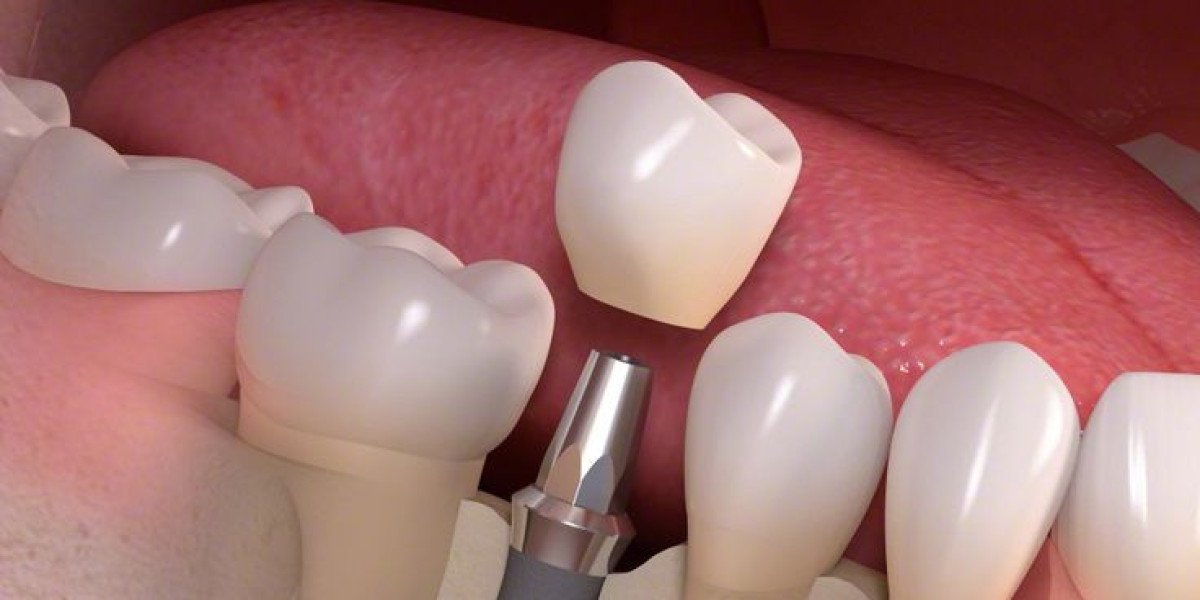Whether due to injury, decay, or other dental issues, missing teeth can significantly impact both oral health and self-confidence. Dental implants provide a way to restore not only the function of lost teeth but also the aesthetics of a natural smile. This article will delve into the world of dental implants, exploring their benefits, the implant process, types of implants, potential risks, and the long-term care required to maintain them.
What Are Dental Implants?
Dental implants are artificial tooth roots, typically made of titanium, that are surgically placed into the jawbone to support a replacement tooth, bridge, or denture. The implants act as anchors, integrating with the bone over time to provide a stable and durable foundation for the replacement teeth. Unlike other restorative options, such as dentures or bridges, dental implants are designed to function like natural teeth, offering superior comfort, strength, and longevity.
The idea of dental implants dates back to ancient civilisations, where materials like shells and stones were used to replace missing teeth. However, modern dental implants, as we know them today, have been developed over the past few decades, with significant advancements in materials, techniques, and success rates. Today, dental implants are considered the gold standard for tooth replacement, providing a reliable and aesthetically pleasing solution for patients of all ages.
Benefits of Dental Implants
Dental implants offer numerous advantages over other tooth replacement options, making them a popular choice for those seeking to restore their smiles. Some of the key benefits include:
Natural Appearance and Feel:
Dental implants are designed to mimic the appearance, feel, and function of natural teeth. Once the implant is in place and the replacement tooth is attached, it is virtually indistinguishable from the surrounding natural teeth. This seamless integration helps restore the aesthetics of your smile and provides a comfortable, natural bite.
Durability and Longevity:
With proper care, dental implants can last a lifetime. Unlike traditional bridges or dentures, which may need to be replaced or adjusted over time, implants are a permanent solution. The titanium used in the implants is biocompatible and resistant to corrosion, ensuring that the implant remains strong and stable for years to come.
Improved Oral Health:
Dental implants help preserve the health of the jawbone by stimulating bone growth and preventing bone loss, which can occur when a tooth is missing. This is because the implant acts as a substitute for the tooth root, maintaining the structure of the jaw. Additionally, unlike traditional bridges, which require the reduction of adjacent teeth, implants do not impact the surrounding teeth, preserving more of your natural tooth structure.
Enhanced Comfort and Functionality:
Unlike removable dentures, which can slip or cause discomfort, dental implants are fixed in place, providing a secure and stable solution. This allows you to eat, speak, and smile with confidence, without worrying about the prosthetic shifting or falling out. The implants also restore the full chewing power of natural teeth, enabling you to enjoy a wider variety of foods.
Convenience and Confidence:
With dental implants, there is no need for messy adhesives or special cleaning routines that are often required with dentures. Implants can be cared for just like natural teeth, with regular brushing, flossing, and dental check-ups. This convenience, combined with the natural look and feel of implants, can significantly boost your confidence and quality of life.
The Dental Implant Process
The process of getting dental implants typically involves several stages, from the initial consultation to the final placement of the replacement teeth. Understanding each step can help you prepare for the procedure and ensure a smooth and successful outcome.
Initial Consultation and Evaluation:
The first step in the dental implant process is a thorough consultation with your dentist or oral surgeon. During this visit, the dentist will assess your oral health, take X-rays or 3D scans of your jaw, and discuss your medical history to determine whether you are a suitable candidate for implants. Factors such as bone density, gum health, and overall health will be considered in the evaluation.
If you have insufficient bone density in the jaw, you may require a bone graft before the implant can be placed. This procedure involves adding bone material to the jaw to provide a stable foundation for the implant. In some cases, other preparatory procedures, such as tooth extractions or gum disease treatment, may be necessary before proceeding with the implant.
Implant Placement Surgery:
Once you are deemed a suitable candidate, the next step is the surgical placement of the implant. This procedure is typically performed under local anaesthesia, although sedation options are available for those who may be anxious or require multiple implants.
During the surgery, the dentist or oral surgeon will make an incision in the gum to expose the jawbone and then drill a small hole into the bone where the implant will be placed. The titanium implant is then inserted into the hole and secured in place. After the implant is placed, the gum is sutured closed, and the healing process begins.
Osseointegration:
One of the key factors contributing to the success of dental implants is osseointegration, the process by which the implant fuses with the surrounding bone. This process typically takes several months, during which the bone grows around the implant, securing it firmly in place. During this time, a temporary crown or denture may be provided to maintain aesthetics and function.
Osseointegration is crucial for the long-term stability of the implant, as it ensures that the implant can withstand the forces of chewing and other daily activities. Your dentist will monitor your progress during this healing period and advise you on how to care for the implant to promote successful osseointegration.
Abutment Placement:
Once osseointegration is complete, the next step is the placement of the abutment, a small connector that attaches to the implant and protrudes above the gumline. The abutment serves as the attachment point for the replacement tooth or teeth. In some cases, the abutment may be placed at the same time as the implant, while in others, a second minor surgery may be required to attach the abutment.
Placement of the Replacement Tooth:
After the gum tissue has healed around the abutment, the final step is the placement of the custom-made replacement tooth, crown, bridge, or denture. This prosthetic is designed to match the colour, shape, and size of your natural teeth, ensuring a seamless and natural-looking result.
The replacement tooth is secured to the abutment, completing the dental implant process. Your dentist will ensure that the prosthetic fits comfortably and functions properly, allowing you to enjoy your restored smile.
Types of Dental Implants
Dental implants can be classified into several types based on their design, placement method, and the number of teeth they replace. Understanding the different types of implants can help you and your dentist choose the best option for your specific needs.
Endosteal Implants:
Endosteal implants are the most common type of dental implant and are typically shaped like small screws or cylinders. They are placed directly into the jawbone, where they serve as the root for the replacement tooth. Endosteal implants are suitable for most patients with sufficient bone density and are used to replace single teeth, multiple teeth, or even a full arch of teeth.
Subperiosteal Implants:
Subperiosteal implants are less common and are typically used for patients who do not have enough healthy bone to support endosteal implants and cannot undergo bone grafting. Instead of being placed directly into the bone, subperiosteal implants sit on top of the jawbone, just under the gum tissue. A metal framework with posts extends through the gums, and the replacement teeth are attached to these posts. While subperiosteal implants offer an alternative for those with insufficient bone, they are generally less stable than endosteal implants.
Zygomatic Implants:
Zygomatic implants are a specialised type of implant used in cases where the upper jawbone is severely resorbed and cannot support traditional implants. Instead of being anchored in the jawbone, zygomatic implants are placed in the cheekbone (zygomatic bone), which provides a strong foundation for the implants. This technique can eliminate the need for bone grafting and is often used in full arch restorations.
All-on-4 Implants:
The All-on-4 technique is an innovative approach to full-arch restoration that uses just four implants to support an entire arch of replacement teeth. Two of the implants are placed at an angle to maximise contact with the bone, providing a stable foundation even in cases of reduced bone density. All-on-4 implants offer a cost-effective and efficient solution for patients who need to replace all of their upper or lower teeth.
Mini Dental Implants (MDIs):
Mini dental implants are smaller in diameter than traditional implants and are often used in cases where there is not enough space for a standard implant or when only a small amount of bone is available. MDIs are commonly used to stabilise lower dentures, providing a less invasive and more affordable alternative to full-sized implants.
Potential Risks and Complications
While dental implants have a high success rate, as with any surgical procedure, there are potential risks and complications to consider. Understanding these risks can help you make an informed decision and take steps to minimise the likelihood of complications.
Infection:
Infection at the implant site is one of the most common complications associated with dental implants. This can occur if bacteria enter the surgical site during or after the procedure. Symptoms of infection may include pain, swelling, redness, and discharge from the implant site. In some cases, the infection may require antibiotic treatment or even the removal of the implant.
Implant Failure:
Although rare, dental implants can fail if they do not integrate properly with the bone. This may occur due to insufficient bone density, excessive pressure on the implant during the healing process, or other factors. Signs of implant failure include pain, loosening of the implant, and persistent inflammation. If an implant fails, it may need to be removed and replaced after the area has healed.
Nerve Damage:
Nerve damage is a potential risk during the implant placement procedure, particularly in the lower jaw. This can result in numbness, tingling, or pain in the lips, chin, or tongue. While nerve damage is usually temporary, in some cases, it may be permanent. Careful planning and the use of advanced imaging techniques can help minimise the risk of nerve damage.
Sinus Issues:
For implants placed in the upper jaw, there is a risk of sinus perforation if the implant extends into the sinus cavity. This can lead to sinus infections or other complications. In cases where there is limited bone height in the upper jaw, a sinus lift procedure may be performed to create more space for the implant.
Bone Loss:
Although dental implants are designed to prevent bone loss, in some cases, bone resorption can occur around the implant over time. This can lead to implant instability and may require additional treatment, such as bone grafting or implant removal.
Long-Term Care and Maintenance
To ensure the long-term success of dental implants, proper care and maintenance are essential. While implants are highly durable, they still require attention to prevent complications and maintain oral health.
Oral Hygiene:
Maintaining excellent oral hygiene is crucial for the health of your implants. This includes brushing at least twice a day, flossing daily, and using an antibacterial mouthwash to reduce the risk of infection. Special tools, such as interdental brushes or water flossers, may be recommended to clean around the implant.
Regular Dental Check-Ups:
Regular visits to your dentist are important to monitor the health of your implants and detect any potential issues early. During these check-ups, your dentist will assess the condition of the implant, gums, and surrounding teeth, and may take X-rays to ensure the implant is securely integrated with the bone.
Avoiding Harmful Habits:
Certain habits, such as smoking, chewing ice, or grinding your teeth, can increase the risk of implant complications. Smoking, in particular, can impair the healing process and increase the likelihood of implant failure. If you grind your teeth, your dentist may recommend wearing a nightguard to protect the implant and surrounding teeth.
Healthy Lifestyle:
Maintaining a healthy lifestyle, including a balanced diet, regular exercise, and avoiding excessive alcohol consumption, can support the overall health of your implants and contribute to successful long-term outcomes.
Conclusion
Dental implants have transformed the way we approach tooth replacement, offering a durable, natural-looking, and long-lasting solution for those who have lost one or more teeth. With a variety of implant options available, patients can find a solution that meets their specific needs and restores their smile with confidence. While the process of getting dental implants requires careful planning, surgical precision, and a commitment to oral hygiene, the results are well worth the effort. By understanding the benefits, risks, and maintenance requirements of dental implants, you can make an informed decision and enjoy the many advantages that come with this innovative dental technology. Whether you need to replace a single tooth, multiple teeth, or an entire arch, dental implants offer a reliable and aesthetically pleasing solution that can enhance your oral health and quality of life for years to come.








